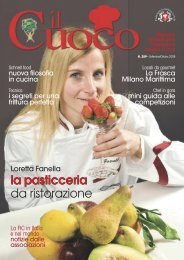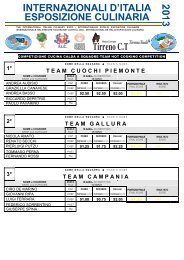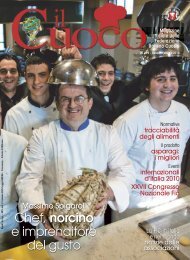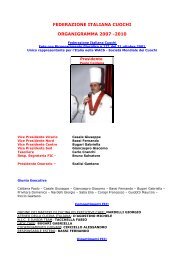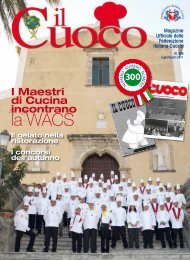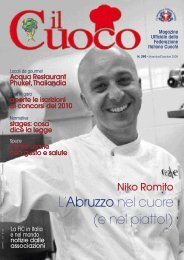Scarica versione PDF - Federazione Italiana Cuochi
Scarica versione PDF - Federazione Italiana Cuochi
Scarica versione PDF - Federazione Italiana Cuochi
You also want an ePaper? Increase the reach of your titles
YUMPU automatically turns print PDFs into web optimized ePapers that Google loves.
ILCUOCOINTERNATIONALSEEPAGE16FOR THE ITALIAN TEXTFrom stoneknivesto ceramicbladesby di EugenioMedaglianiHard and sharp, that’s what blades shouldbe like. And it is curious to note that flint s-tone, which they were made of more than 3thousand years ago, is making a comeback todaybeing used in precious ceramic knives.How can you imagine, a chef withouta chopping knife, a butcher without aboucher, a diner without a table knifeor a housewife without a peeling knife?Primitive man already used tools tocut up, pare, and slice. The first kniveswere fragments of flint stone, a veryhard stone, the sharp-edged, jaggededges of which presented a kind ofsharp, cutting blade suitable for removingthe hide of animals and scrapingthe hides with which primitiveman covered himself.The discoveries of scholars have allowedustofinddeepinthebowelsofthe earth the tools which primitiveman created to provide for the needs oftheir existence. In all archaeological museumsyou can see examples of axes, arrowheads, spears and stone knives.Some years ago, American researchersat Berkley University in Californiadiscovered in a dry river bed in the A-far region in Ethiopia, something like3 thousand sharp stone shards andfragments of river pebbles from whichthe fragments themselves were obtained.These objects dated back to 2million 500-600 thousand years ago,moving the period to which the firstproduction of stone tools by our ancestorswas attributed back by morethan 500 thousand years. In the Afarbed no Hominidae remains were foundbut the find throws light on a period between3 and 2 and a half million yearsago, which coincides with the transitionof the Australopithecines (to whomthe famous Lucy belongs) and the appearanceof the “homo” group. Themost wide-spread opinion among scholarsis that there was a relationship betweenthe capacity to produce stone implementsand the increase in the size ofthe brain.The production of stone tools is a significantphase in the cultural developmentof man, because our ancestors,having the advantage over animals inthat they possessed a blade, could findfood by more widely exploiting the varietiesof vegetation offered by the savannah.What clearly emerges fromthe new finds is that, in the distant past,the makers of these objects alreadyclearly knew how to make tools withwhich to butcher and skin animalsand cut roots. It is extraordinary to observehowthetechniqueusedtoproducethese tools has remained unchangedfor almost one million years.Let us take a leap forward of almost3 million years to discover that there areJapanese companies which producecutting tools with an Ish Ba ceramicblade, a very hard mixture with a similarappearance to that of ceramic. It isan alloy obtained through a process ofsintering of powders of zirconium oxide( a mineral similar to obsidian andflint stone) and aluminium oxide, athigh temperatures and pressures. Theapplication of this particular alloy toknives guarantees some particular features:an excellent seal on the edge ofthe knife which does not retain flavoursand does not cause chemical reactionswith foods, especially fruit and vegetables.They are stainless and hygienic,anti-magnetic and anti-allergic (theydo not contain nickel) and are light andeasy to handle and easy to use andwash.In the daily use of these knives, someprecautions should be taken: do not exerta strong side pressure because theseblades are not suitable for boning. Donot use them on meat or fish bones, onfrozen products and on glass or stainlesssteel work surfaces.In the Mohs scale, which expresses thehardness of minerals, only the diamondis harder than these blades!SEEPAGE20FOR THE ITALIAN TEXTHam: whenthe pigflies “high”!by Sergio G. Grassofood anthropologistHigh hills and mountains are the ideal environmentsfor producing and maturing hams.From San Daniele del Friuli to Sauris, fromNorcia in Umbria to the Tuscan Casentino,from Upper Irpinia to Bosses in the valled’Aosta, we have an anthology of gastronomic“pearls” making us the envy of the wholeworld.The words pork, pig, piglet and swinerepresent for man the archetype of negativity,lechery, filth and gluttony. Amalice and unnatural lack of gratitudedesired by homo-sapiens to the detrimentof honest mammals to which naturehas given tasty meat, succulent fat,flavoursome offal and so many preciousthings of which, as we all know, nothingis wasted. Least of all the legs eventhough they are situated in an unfortunateposition for the anatomy.By the word “prosciutto” (ham) we generallymean the pig’s leg (coscia). Not justas mother nature made it to allow the pigto walk, but salted and matured. Insome areas of Italy they also give the samename to the corresponding cut of freshmeat, more correctly called “coscio”.THE “DRIED” MEATAND SERVE ITThe term “prosciutto”, which Gianni Brerausedtosay“hasthesoundoftheslicingmachine”, derives from the vulgarLatin adjective perexuctus (i.e. withoutany liquid) which became “presciutto”,used as an alternative to prosciutto, even74|




